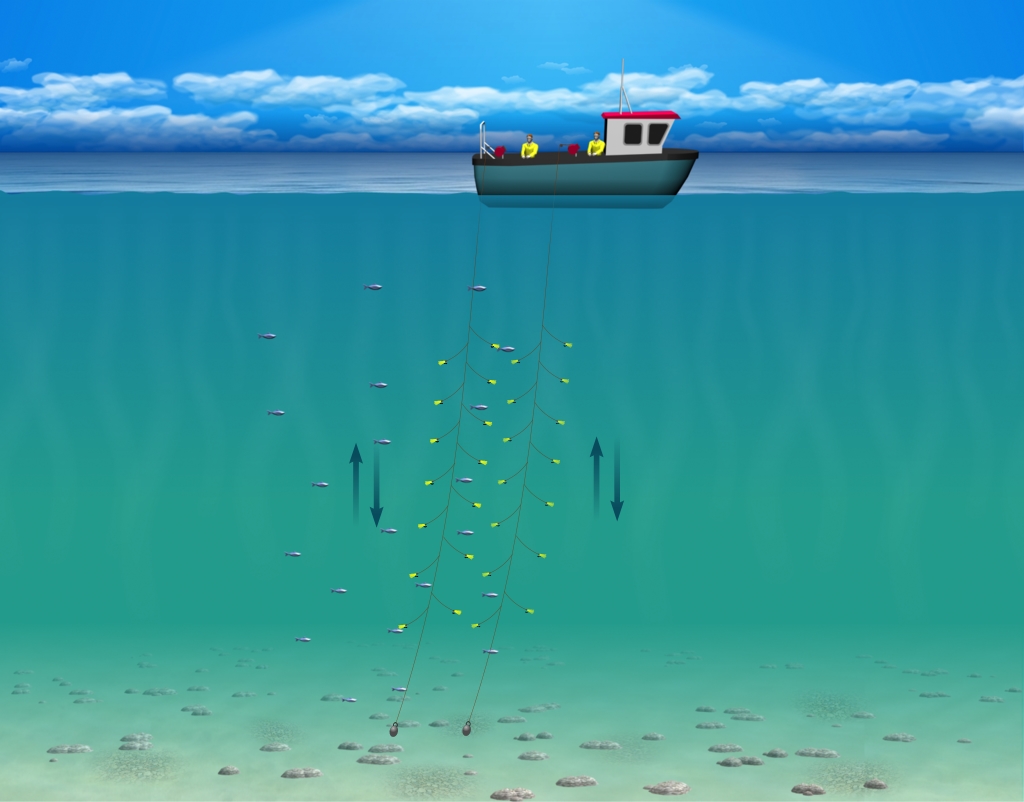Jigging
Alternative names
-
- Hand line
Summary
Jigging is a method of fishing that has evolved over many centuries, where hooks attached to artificial lures are used to attract and capture fish. The lures are designed to resemble small fish that the target species would normally feed on. They are usually operated in a rhythmic up and down motion to simulate the movement of small fish, but often particularly if the fish are feeding well, the very movement of lowering the jig to the required depth is enough for the fish to take the jig and be caught.

Environmental impact
Jigging is very environmentally friendly. The gear is only shot in specific areas where there are known conglomerations of target species. For pelagic species such as mackerel it is a more targeted fishery with the vessel ‘searching’ for a shoal of fish before deploying the jigs. By-catch is minimal with any unwanted by-catch being able to be returned to the sea immediately and unharmed. Size selection can be regulated fairly well by careful selection of hook size. Many jig fisheries are done on a seasonal basis and in specific areas.
The lines and their weights will have negligible seabed impact with most of the actual fishing being undertaken clear of the seabed. Occasionally there may be some environmental and possibly ethical problems with the large ocean going squid jigging vessels.
Other information
Originally this method would be operated by one fisherman with only one line with a basic lure on it and some fisheries still operate in this way. Today most jig fisheries involve the use of multiple jigs on each line enabling several fish to be caught at once. However with the use of modern materials and computer-controlled jigging machines to handle the lines has enabled one person to operate several lines and promote the debate can this still be classed as ‘hand lining’.
In the UK, jigging is used commercially in several different areas. In South West England it is used in the handline fishery for mackerel. This is a small boat fishery, usually boats under 10m, operated on a single handed basis. In this fishery one man will use a single line with a weight and multiple hooks on it, often as many as 20 or 30 hooks. These hooks will have a small feather or piece of coloured plastic on them to act as a lure, sometimes the fish will go for a bare shiny hook without the need for feathers. The lines will be hauled by hand and the fish shaken off as they come aboard or the line may be hauled and stowed on a large reel known as a ‘gurdy.’ In this case the line is often hauled through a device called a stripper that strips the fish from the hooks as it comes onboard. This enables the line to be shot away again as soon as the last fish has been removed from the line. At certain times of the year some of the boats will change their rig and move to jigging for pollack or squid.
In North East Scotland where ‘hand lining’ for mackerel’ has developed more recently most fishermen have opted to use the electronic jigging machines. The lines are similar to that used in the South West but they are operated using the computer controlled electronic machines that can be programmed to drop the lures to a set depth then retrieve them when a fish has taken the lure. On retrieval the line is hauled through a ‘stripper’ that strips the fish off the line and channels directly them into a plastic box. Use of this system enables one man to operate as many as four machines each with up to 30 lures on it. Although in the Scottish fishery the lines are hauled by a machine the fish are still referred to as ‘handline caught’.
The handline fishery is seen as a very selective method of fishing with very little bycatch. If there is any unwanted bycatch it can usually be returned to the sea alive and unharmed giving an almost zero discard rate. It is pursued by small low powered boats using very little fuel and as the gear is never in contact with the seabed has minimum environmental impact. It is a well-managed fishery throughout the UK that produces a high quality product.
Jigs are used to attract and catch fish in various forms throughout the world. The one that is probably most commonly heard about is the jig fishery for squid exploited by many nations, both inshore and in deeper offshore waters. In this fishery powerful lights are used to attract and congregate the squid beneath the vessel. These vessels will operate multiple lines with jigs on, either by hand or using automated jigging machines. The squid jigs generally have a ring of barbless hooks on them that allow the squid to drop off the hook once onboard the vessel and the line goes slack. There is some jigging for squid in the UK but it tends to be concentrated in South West England on a seasonal basis.
Gear classification
Main target species (UK)
-
- Cod
- Mackerel
- Pollack (Lythe)
- Saithe
- Squid
Possible bycatch
-
- Very little bycatch